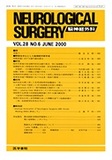Japanese
English
- 有料閲覧
- Abstract 文献概要
- 1ページ目 Look Inside
Ⅰ.はじめに
脳動脈瘤手術における一時血流遮断は動脈瘤の剥離操作,およびclippingに際して有効な手段であるものの10,22,23),脳虚血が問題となる18).その際の脳保護法としてvitamin E,phenytoin24),mannitol26),barbiturate15),propofol,etomidate4)などの薬物が用いられてきた.一方,術中低体温は古くから臨床応用されており,1950-1970年代にかけて25-29℃の中等度低体温管理下での動脈瘤手術が行われていた12,20).血流遮断時間の延長,dry field下での手術,脳容積の縮小といった利点がある一方,心室細動をはじめとする心機能異常,低カリウム血症,凝固異常,術後の頭蓋内出血などの重篤な合併症が多く12),次第に行われなくなった.ところが,近年32-34℃の軽度低体温による脳保護効果が実験時に示され5,10),再び低体温管理が注目されるようになった8,9).脳代謝を抑制し,脳酸素消費量を減少させることにより虚血耐性を高めるという従来からいわれていた機序1,20)に加え,軽度低体温ではフリーラジカル生成の抑制11),興奮性アミノ酸の放出抑制17),組細胞内カルシウム蓄積の抑制16)なども関わっていると考えられている.
軽度低体温下では中等度低体温下でみられたような重篤な合併症がないとされ,臨床応用されるようになった.しかし,ICUにて長期的に軽度低体温管理を行った場合は循環抑制,呼吸器合併症,血液凝固異常,ホルモンの変化などが管理上大きな問題となっている21).術中のみの軽度低体温では循環動態に対する影響は比較的少ないとされてきたが2),実際に脳および全身の血行動態の変化を検討した報告は稀である.そこで術中軽度低体温が全身および脳の循環動態に及ぼす影響について検討した.
Systemic and cerebral hemodynamics were evaluated through pulmonary artery and jugular bulb cathe-ters in 31 patients with cerebral aneurysms. The temperature of the pulmonary artery was lowered to 33-34℃ during surgeries. Systemic circulation deteriorated during mild hypothermia, but cerebral circulation showed a little improvement. Cardiac function recovered by rewarming, but the balance between systemic oxygen supply and demand did not always improve. Therefore, a strict monitoring of systemic circulation is necessary even when the hypothermia is only mild and vasodilator or inotropics would be indicated. Rapid rewarming should be avoided, especially when surgical retraction of the brain is strong or temporary occlusion is prolonged.

Copyright © 2000, Igaku-Shoin Ltd. All rights reserved.


